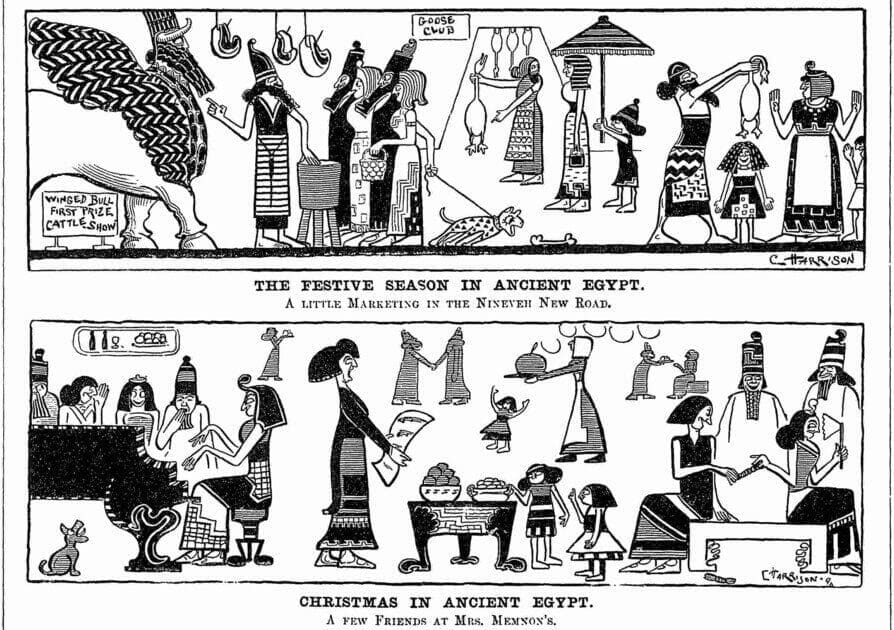│By Tamar Atkinson, Gale Ambassador at the University of Liverpool│
The nineteenth century is generally considered to be the period when Egyptology started to develop as an academic discipline, with key moments occurring during this century, such as Jean-François Champollion deciphering hieroglyphs in 1822 (200 years ago this year!). In correlation, we see a great increase in the popularity and depiction of Ancient Egypt in society as a whole, and what has come to be described as Egyptomania (a great enthusiasm for Egypt within popular cultural consciousness). Consequently, it is no surprise that we see this fascination with Ancient Egypt reflected in primary source documents from the time, as is evident in the visualisation below which charts the frequency of use of the term ‘Ancient Egypt’ in documents from Gale’s Nineteenth Century Collection Online.
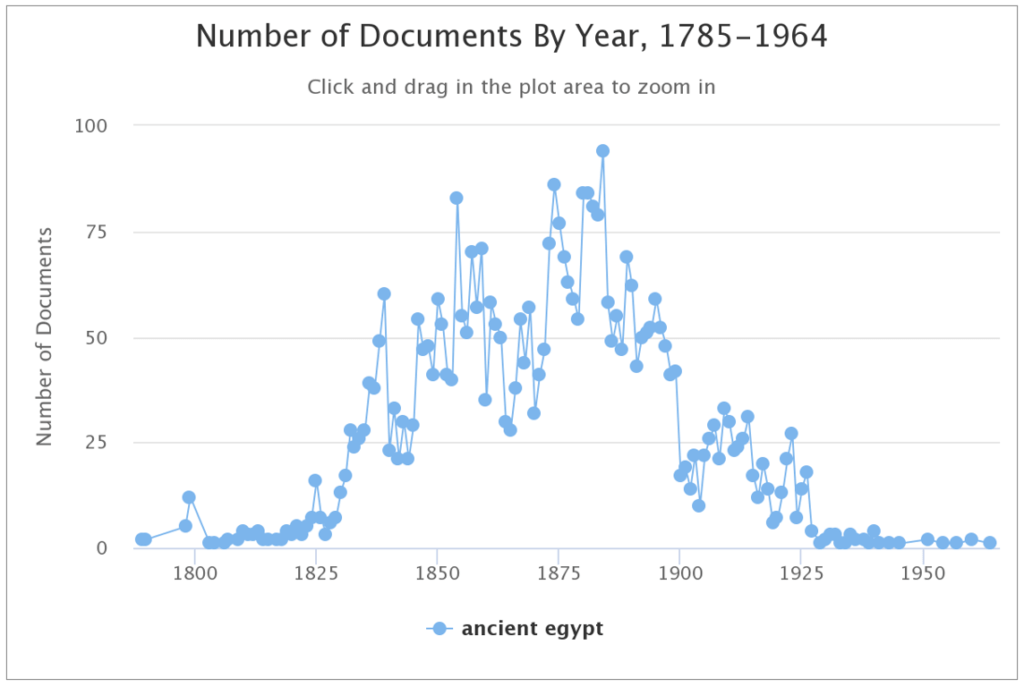
By looking at a sample of these newspaper reports, we can gain an idea of how Ancient Egypt was perceived, both academically and in art and wider society, and come to understand what new information was appearing at this time.
New Discoveries and Developments Within Academic Egyptology
We see a whole range of new discoveries being reported within Egyptology at this time, from the discovery of the Middle Kingdom town of Kahun (Berrows Worcester Journal, 1892), to the opening of pyramids at Saqqara (The Watchman, 1881). We can also see the nature of Egyptological academic discourse during this time. A review in The Leader, for example, of Osburn’s Monumental History of Egypt, discusses debates over the connection of the Coptic language to that of Ancient Egypt, as well as issues with the translation of Ancient Egyptian scripts. Thus, researching within these contemporary newspapers, we can come to understand what new information and scholarship on Ancient Egypt was emerging in the nineteenth century – and compare this to the developments made in recent years that further our knowledge in the same areas.
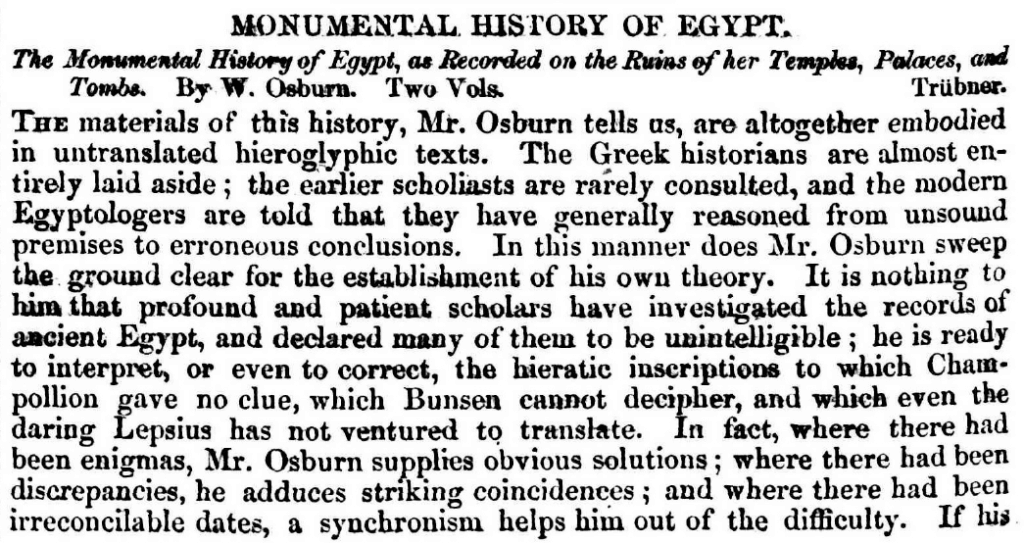
Fascination in the Popular Imagination Evident Through Art
Not only do we see academic developments, we also see that Ancient Egyptian civilisation had a great influence on art and media in the nineteenth century. An example of this is print coverage of the ‘Cyclorama of Ancient Egypt’ exhibited in the Niagara Hall at Westminster. Articles from the Daily News and The Era, both from 1891, describe this to have been ‘a vast pictorial representation of many famous elements of Ancient Egypt’, which sparked great interest in spectators. The artwork is also described as being accompanied with an Egyptian band, an arranged guide and description, and a bazaar set out to look like a modern street market in Cairo.
This clearly demonstrates that the idea of Ancient Egypt was an aesthetic spectacle which intrigued many members of the wider public in the nineteenth century. Indeed, I would argue that, with so much still to be discovered about this ancient civilisation at that time, much of the attention it attracted was due to the somewhat fictional nature it still held for many people in the nineteenth century.
We can see similar enthusiasm for Egyptology through the publication of illustrations, such as the examples below from Punch which were both published in 1897, in volumes 112 and 113 respectively. While these are intended for humorous purposes, they can also provide useful insight into ideas surrounding Egyptology and the way Ancient Egypt was perceived in the popular imagination in the nineteenth century.
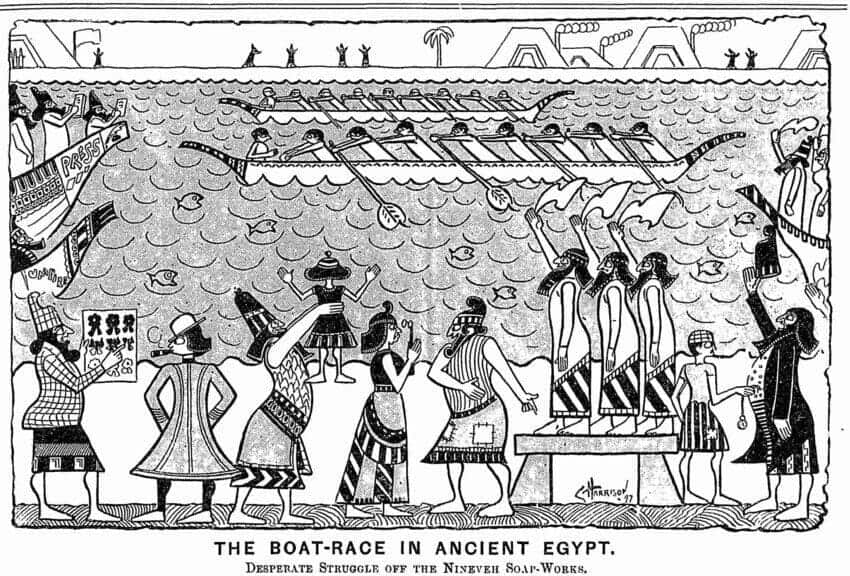

Links to Christianity
Much of the discussions we find in newspapers of the nineteenth century involve drawing a link between Biblical studies and Ancient Egypt. One example of this is a lecture by a Mr. F. Harris which was covered by the Chelmsford Chronicle in 1894, with the newspaper noting that Harris ‘spoke chiefly upon the period covering the bondage and exodus of the children of Israel’. The article also suggests comparison was made between discoveries in Egypt and the stories in the Bible, suggesting ‘the more carefully he examined the books of Moses, and the more carefully he compared them with facts which had come to light, the more evidence he found of the absolute accuracy of the writings of Moses’. This can demonstrate to us how important religion was in how Ancient Egypt was perceived during the nineteenth century, impacting any discoveries and influencing perceptions at this time.
Preserving Ancient Egyptian Culture
We can also see a clear desire at this time to protect what remained of the Ancient Egyptian civilisation. In an article from the Dover Express from 1890, we can see that there were ongoing discussions about the destruction of Ancient Egyptian monuments, as a result of demands for building materials. We also see mention of the Society for the Preservation of the Monuments of Ancient Egypt in an issue of the Birmingham Daily Post from 1894, highlighting how many individuals were protesting the submersion or removal of ancient monuments in forming a reservoir at Philae. Whether individuals wanted this to be protected for the purpose of furthering archaeological discoveries, or for simply keeping elements of Ancient Egypt in good condition for their aesthetic value, there was a clear wish to preserve what remained of Ancient Egyptian culture – not unlike today!
Progress Still to be Made
While we can acknowledge the great progress that was made at this time in understanding Ancient Egypt, there is clear evidence in these newspapers that much progress still needed to occur. One quote from an article published in the Nottinghamshire Guardian in 1851 summarises the situation: ‘No other people have left us such profuse materials of a certain kind to assist our investigations; yet none are so mute, so enigmatical, so absolutely withdrawn into the recesses of the past.’ This shows a great awareness of how much there still was to discover.
Not only this, but we can see the progress that still needed to be made within contemporary society, so far as the ways attitudes and beliefs were impacting interpretations of Ancient Egypt. For example, The Methodist includes an article in 1878 on women’s rights in Ancient Egypt, noting that women appeared to have more rights than women in Britain at that time. The article is clear, however, that this was perceived negatively by the author, describing men as being ‘a wronged and submissive being’. This is just one example of how, as our own contemporary views and attitudes change over time, so too will our views of Ancient Egypt.

Newspapers Can Shed Light on Academia, Popular Culture and Social Outlook
In summary, as we can see from the quote in the image below, Ancient Egypt fascinated the British during the nineteenth century, and it continues to inspire imagination, discussion and research around the world today. Through looking at just a sample of newspapers, we can gain a lot of valuable information on academia, popular culture and outlooks during this time. It will be interesting to see further developments within Egyptology in the coming decades, and look back with hindsight on what publications of today were publishing!
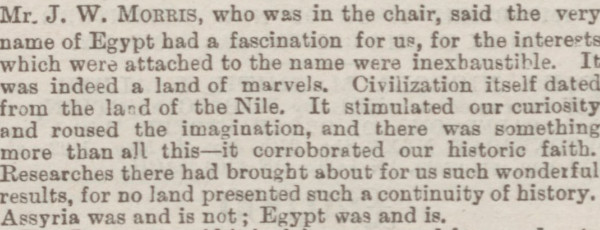
If you enjoyed reading about perceptions of Ancient Egypt and nineteenth-century newspapers, check out:
- King Tut and Digital Humanities: A Pedagogical Case Study
- Why study regional and local newspapers?
- British Library Newspapers, Part VI: Ireland 1783-1950
- Linguistic Analysis of Nineteenth-Century Theatre Reviews in The Times
- Finland in American News in the Late Nineteenth Century
- Tourism and Technology within The International Herald Tribune Historical Archive
Blog post cover image citation: Harrison, C. “The Festive Season in Ancient Egypt. A Little Marketing in the Nineveh New Road.” Punch, 1 Jan. 1897. Punch Historical Archive, 1841-1992, https://link.gale.com/apps/doc/ES700320572/GDCS?u=livuni&sid=bookmark-GDCS&xid=bd3cce53

